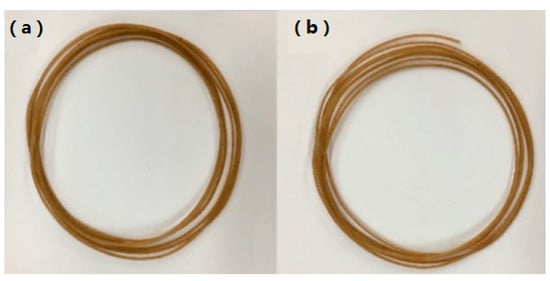Natural fibres (NF) are known as hair-like raw material that is obtained from animals, plants or mineral sources. The main difference between animal and plant fibre is that animal fibre is mainly made out of protein, whereas plant fibres are composed of cellulose. Examples of natural fibre that is derived from plants include rice husk, wheat, hemp, bamboo and cotton. Thiranan Kunanopparat et al.
[34] reported that the mechanical properties of wheat composites were less sensitive to thermal treatment when the fibre content was increased. The processing temperature was reported to be an important parameter that affected the physical adhesion, whereby this physical adhesion played a big role in the mechanical properties of the composites. Chen et al.
[35] reported that bamboo fibres have much lower volumes of fracture behaviours, high proportions of fibre dissociations and matrix failure due to its hierarchical fibrous woven structure. On the other hand, Sueli Aparecida de Oliveira et al.
[36] reported that composites that have natural cotton fibres as fillers exhibited a reduced environmental impact as compared exclusively to PLA or PLA/thermoplastic starch (TPS)-based thermoplastics. Moreover, the natural cotton fibre composites had a better overall performance, under the eco-efficiency perspective. V. Mazzanti et al.
[37] reported that the presence of even small amounts of hemp fibres accelerates PLA degradation to an extent similar to that of residual water in non-dried pure PLA. A natural fibre that can be found abundantly and replenished in a predictable period is known as renewable natural fibre. This NF is commonly used as a low-cost alternative to synthetic fibres (e.g., nylon) mainly due to its biodegradability, cost-effectiveness, satisfactory mechanical properties and low density
[38]. Natural fibre generally has low densities, ranging between 1.1 g/cm
3 and 1.6 g/cm
3, and thus result in low weight
[8]. Plant fibre generally contains 60–80% cellulose, 5–20% hemicellulose, while the rest constitutes lignin, waxes, moisture (up to 20%)
[39]. Besides, the cellulose content or cellulose crystallinity is also a factor to be considered when choosing a reinforcement for polymer. For example, bast fibre with 50–90% cellulose crystallinity is utilised in various automotive components to achieve better mechanical properties of products in terms of modulus, strength and stiffness
[40]. Moreover, rice husk natural fibre was introduced recently as reinforcement in polymer to form NFRCs. Their high cellulose content would result in higher lignocelluloses fibre strength, which could potentially improve the mechanical properties of composites
[8]. According to Rosa
[11], rice husk can be processed at a higher temperature as compared to wood due to its cellulose and lignin contents. Besides, with its lignocelluloses properties, it represents a potentially valuable source of fibre which could be introduced as a filler or direct substitute for wood
[41]. Since rice husk usually ends up in a landfill and has no other important commercial interest, it is highly recommended to be used as reinforced fibres in composites. With the success of incorporating rice husk with reinforced composites or substitute wood in various applications, it could eventually be beneficial in terms of environmental impact, such as minimising deforestation.
Recently, natural fibres have been widely introduced as additives in additive manufacturing filaments
[42]. It is also gaining popularity in various industrial sectors, such as construction, automotive, thermally insulating and sound-absorbing materials
[43][44]. Engineers are always searching for new materials as well as improving processes to manufacture better products to achieve maximum efficiency, sustainability and simultaneously reduce waste. Reinforcing thermoplastic polymer with natural fibres can cause certain peculiar issues. First, the lignocellulose in natural fibre undergoes degradation during the process of constant high temperature of above 200 °C
[45][46]. Therefore, the melting temperature had to be considered when choosing a suitable thermoplastic. Furthermore, natural fibre drying is important before any processing to prevent the development of water vapour during mixing, and avoid the hydrolysis of polymeric matrices
[47][48]. NFRC is commonly produced through the process of continuous extrusion and used in additive manufacturing. However, this had led to several challenges such as an inhomogeneous mix between filler and polymer matrix
[8], temperature control
[49], as well as the creation of voids during processing
[50][51]. Eventually, these result issue, including nozzle clogging in a 3D printer
[49], and inconsistent mechanical performance. To improve the homogenous mixing between matrices and filler, additives such as coupling agents
[8], chemical treatment
[52][53] and compatibilizer
[54] are added to improve the interfacial bonding between the polymer matrices and filler. Besides, the effect of processing parameters and printing parameters has not been explored deeply until recently.
Table 2 shows the summarised literature investigated by various researchers in NFRC filament and their respective treatments based on some common types of thermoplastics. Each polymer, types of fibre, content percentage and presence of compatibilizer are detailed, together with their respective references. In addition, additives, such as chemical treatments
[52][53][55], compatibilizer
[49], plasticiser
[51][56] and toughening agent
[57] performed on the composites are shown. For instance, Nguyen
[57] reported that toughening agent of nitrile rubber contributed considerably in terms of increased mechanical performance. Stoof
[52] suggested that layer adhesion, reduce in pore size, surface finish and the mechanical performance of the composite can be improved with the addition of a plasticiser. Besides, it can be seen that the fibre amount rarely exceeded 30 wt.%. Higher fibre amount eventually results in more complex printing in the 3D printer such as a non-homogenous mixture of NFRC that could cause blockage at the nozzle
[49], as well as increase the melt viscosity, which requires higher power for extrusion. Moreover, lower polymeric matrices could result in a more brittle filament as the polymer matrix that can wet the fibres decreases
[57].


